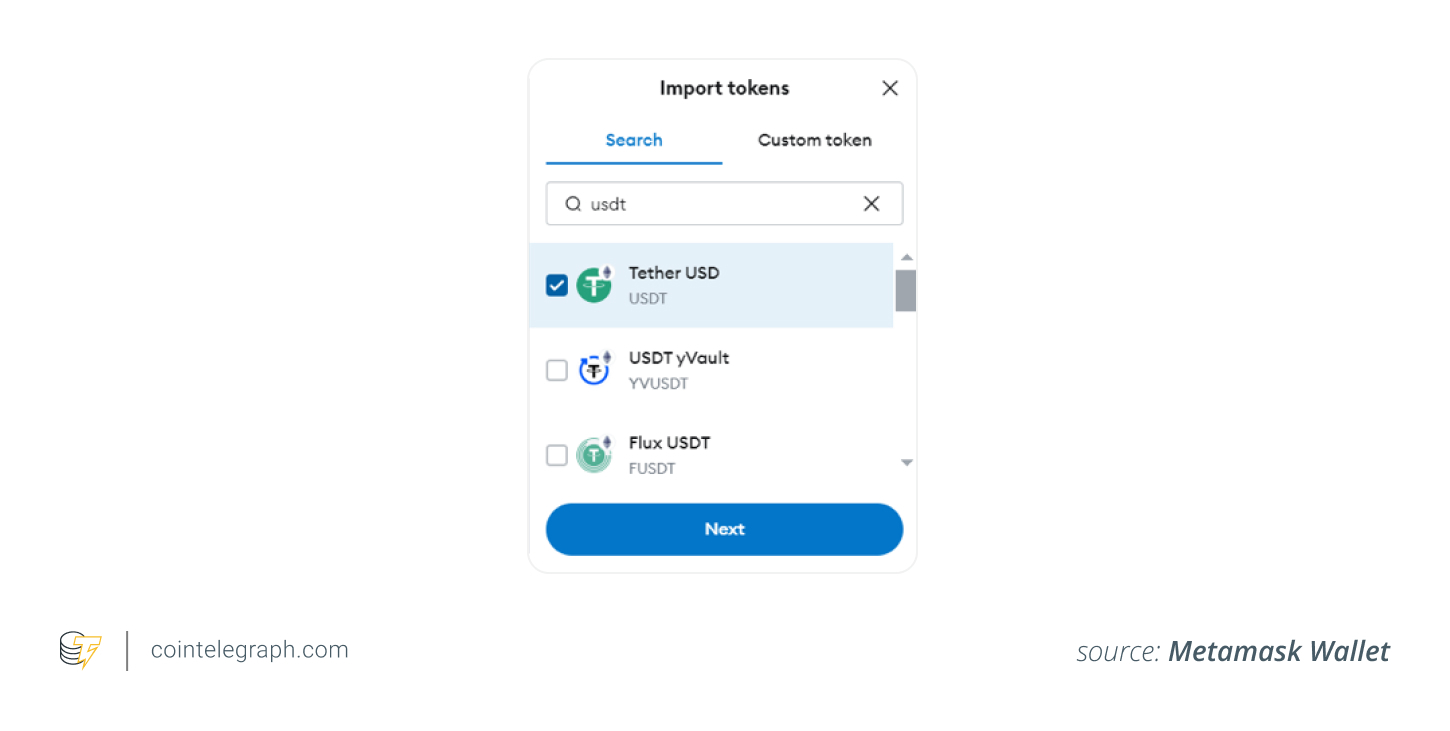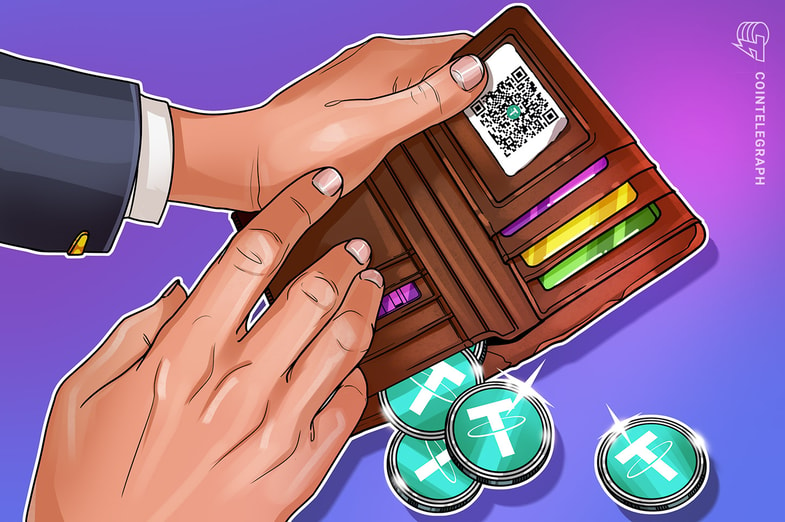Key takeaways
- A USDt wallet address is a unique string of characters, functioning like an account number, that allows users to receive Tether’s USDt on various blockchain networks, such as Ethereum and Tron.
- USDt can be stored in different wallet types, including hardware, software and custodial wallets, each offering varying levels of security and accessibility depending on user preference.
- It is crucial to verify the correct blockchain network (Ethereum, Tron, etc.) before sending or receiving USDt, as using the wrong blockchain address could result in a permanent loss of funds.
- For safe USDt management, consider using hardware wallets, maintaining secure backup copies of recovery phrases and avoiding public WiFi when conducting transactions.
Understanding a USDt wallet address
A USDt wallet address is a string of numbers you use to receive Tether’s USDt (USDT) stablecoin.
This address is known as a public key and is the equivalent of an account number in a traditional bank account or an email address. You can hand it out to people so they can send you cryptocurrency, but they won’t be able to access your wallet with this address.
How does a USDt wallet address work?
When receiving funds in USDt, you give your Tether wallet address to whoever is sending you funds. In addition, it is also used to record the transaction history of USDt on blockchains.
There are different formats for a USDt wallet address depending on which blockchain network it is based on. This is because USDt is available on several blockchains, including Ethereum and Tron, among others.
Generally, the address is 40 characters long. To help identify the blockchain for the address, it uses a different starting format. For example, USDt on Ethereum starts with “0x,” while Tron address formats start with a “T.”
Before sending and receiving USDt, you should always check which blockchain you are transacting on to avoid technical errors and loss of funds.
Did you know? Tether’s user base reached 350 million in 2024, following a 24% surge in growth since October 2023. In comparison, Tether had reached approximately 282 million users by October 2023, which was already a significant jump from 141 million users in 2022. This rapid expansion highlights Tether’s continued dominance in the stablecoin market as it grows in popularity.
Types of wallets for storing USDt
Your wallet address or public key is directly linked to your crypto wallet. In fact, it makes up half of the cryptographic keys that make up your crypto wallet. The other half of this address is your private key, a string of hexadecimal numbers cryptographically linked to the public key.
This private key should never be revealed, as it is used to access and control the crypto in your wallet, making it crucial to choose the right wallet to store your USDt.
Selecting the best wallet for your USDt
USDt crypto wallets in 2024 should securely store your private key while being simple to share your public wallet address to receive funds. There are three main types of wallets to choose from:
- Hardware wallet: A hardware wallet is a device similar to an external hard drive or USB stick that stores your crypto offline. The wallet enables you to store your private key offline, but people can still send funds to your wallet USDt via your public wallet address. Keeping your wallet offline when not in use helps to reduce hacking risks. You only need to connect your wallet to the internet when you need to send funds.
- Software wallet: Software wallets create a USDt wallet address directly on your computer or phone. This makes it easy to send and receive USDt directly from your devices. You retain complete control of your crypto, but security is reduced. As software wallets are generally stored on internet-enabled devices, they are more susceptible to hackers.
- Custodial wallet: When you store your USDt on a centralized exchange (CEX) like Coinbase or Kraken, this is known as a custodial wallet. It is similar to using a bank to hold your money. The institution has complete control of your private keys, meaning they could freeze or even steal your crypto in cases of fraud. Plus, large-scale exchange hacks like Mt. Gox have lost hundreds of millions of dollars worth of funds.
How to get a USDt wallet address: Step-by-step guide
There are several USDt wallet options available, such as MetaMask, Trust Wallet, Ledger and Trezor.
In this example, you will learn how to get a USDt wallet address in MetaMask. Follow this crypto wallet setup guide:
- Visit https://metamask.io/, click “Download,” and choose your browser for the installation — e.g., Chrome, Brave, etc.

- Add to browser. You’ll then be taken to your browser extension store, where you can complete the download and installation for your Tether wallet creation.

- Open the MetaMask extension and create a new wallet. Follow the step-by-step setup process.

- Write down your recovery seed phrase. Make sure to record your phrase carefully and store it securely offline so it is not susceptible to hackers.

- Add USDt to your wallet address. To complete your USDt wallet setup, click “Import Tokens” and select USDt from the list. You’ll then see USDt listed in your wallet.

- Receiving address: Now you can receive USDt via your Ethereum receiving address. Either copy your Ethereum receiving address or use the QR code.

- Any Ethereum USDt sent to this address will now show up in your MetaMask wallet.
How to use a USDt wallet for transactions
Once you have received USDt in your wallet, you can start using it to pay for other transactions.
To send funds, click “Send” on the USDt token page of your wallet. Then enter the recipient’s receiving address and the amount you want to send. Check the details carefully and the fees before confirming the payment.
Wallets like MetaMask also give you the option to swap and bridge tokens in your wallet. You can use the swap function to quickly trade between cryptocurrencies. The bridge function allows you to move USDt across chains, for example, from the Ethereum blockchain to the Tron blockchain.
Is keeping money in USDt safe?
Cryptocurrencies are an unpredictable roller coaster ride. USDt offers investors a more predictable and smoother journey. Since it is a stablecoin pegged 1:1 to the US dollar, it’s as stable as the underlying asset, helping it to be an efficient and reliable way to manage money digitally.
It can be used as a trading pair to bridge between currencies or hold a stable value of funds when waiting for markets to move while still retaining the key decentralized features of any strong cryptocurrency.
However, it’s important to note that even stablecoins like USDt are not immune to market disruptions. In May 2022, for instance, USDt briefly lost its peg, dropping to around $0.95 during a period of market turbulence. Although it quickly recovered, this incident shows that while USDt offers stability, it can still experience short-term depegging in extreme market conditions.
Did you know? Markets in Crypto-Assets (MiCA) introduced strict regulations for stablecoins, particularly focusing on transparency and liquidity. To comply with these new guidelines, exchanges like Coinbase may remove non-compliant stablecoins like USDt if they fail to meet MiCA’s regulatory standards.
Managing your USDt safely
To manage your USDt safely, you should consider the following practices:
- Use a secure wallet: Using a trustworthy and robust wallet is critical for storing your funds. The securest option is always a hardware wallet like Trezor or Ledger to store funds offline. Ensure that you keep up with regular updates and use unique passwords for your wallet.
- Backup and recovery: When setting up your wallet, take a careful record of the recovery seed phrase. Keep it as a non-digital/offline hard copy; pen and paper can’t be hacked! Plus, store it in a secure, fireproof location.
- Beware of phishing attacks: Before connecting your wallet or entering sensitive information to a platform, always verify the URL. Don’t click on suspicious links or download unknown attachments. It only takes one wrong link click to cause a USDt wallet security breach.
- Use reputable exchanges: Trade your USDt on reputable exchanges like Coinbase and Binance. Always research new platforms and ensure there are strong security measures in place.
- Avoid public WiFi: Conduct your USDt transactions over secure private networks. Public WiFi is dangerous as it can expose your device and personal information via session hijacking, phishing, data theft and evil twin attacks.
Troubleshooting common USDt wallet issues
Having trouble with your USDt wallet? Here are the most common issues and how to fix them:
- Transaction delays: Network congestions can cause delays. You can check the network and transaction status on platforms like Etherscan. To help transaction speed, ensure you’ve paid sufficient transaction/gas fees for priority processing.
- Lost wallet: If you lose your wallet, you’ll need your recovery seed phrase or private key to reinstall your USDt wallet. Without these, it is impossible to recover your funds.
- Compatibility: Enure your wallet supports the specific USDt blockchain you’re using — e.g. Ethereum, Tron, etc. Plus, make sure you are aware of which chain you are transacting on before sending and receiving crypto.
- Incorrect transaction: Double-check the receiving address before sending USDt. Once a transaction is sent and confirmed, it can’t be reversed, making USDt address verification crucial.
- USDt amount fluctuation: The price of USDt can change very slightly. While it is pegged to the US dollar, sometimes the market price can slip up or down by around $0.0001. This leads to minor fluctuations in the value of funds in your wallet.
If you’re just getting started using USDt, make sure to refer to this USDt wallet address tutorial and wallet setup guide as you go. It might be wise to start practicing transactions with small amounts of funds until you are confident in the functionality and security of your USDt wallet address.


